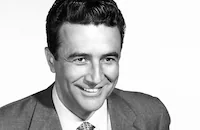Voodoo Tiger
Brief Synopsis
Cast & Crew
Spencer G. Bennet
Johnny Weissmuller
Jean Byron
James Seay
Jeanne Dean
Charles Horvath
Film Details
Technical Specs

Synopsis
In the jungles of Africa near the city of Watusi, professional guide Jungle Jim has been assigned by the government to escort British Museum researcher Phyllis Bruce on a search for the elusive African tiger. As Jim and police sergeant Bono lead Phyllis deep into the jungle, they come upon a sacrificial voodoo ritual led by witch doctor Wombulu. Jim breaks up the ceremony, which is being conducted by natives from various tribes, all fanatics of the voodoo tiger god, Tambura. When Wombulu attacks Jim for burning the tiger god effigy, Jim is saved by game hunter Abel Peterson and his henchmen, Michael Kovacs and Jerry Masters. Peterson explains to Jim that they are looking for a man, but before he can identify him, Jim receives an urgent summons from Commissioner Kingston to meet him at the Watusi airstrip, where he is arriving with Maj. Bill Green of the U.S. Army. At Watusi, Kingston asks Jim for information about Carl Werner, a German who runs a small trading post nearby. At the store, Kingston questions Werner about the whereabouts of Heinrich Schultz, the last known Nazi survivor with knowledge of the famed stolen Schulman Art Collection. Werner declares that he knows nothing about the collection, but Kingston and Bill reveal that a native has informed them that seven years earlier he led Schultz into the jungle and can identify Werner as Schultz. Just then, Peterson and his men arrive at the trading post, and when Bill recognizes them as art thieves who fled America and were kicked out of Germany, a fistfight ensues, during which Werner escapes. Peterson, Masters and Kovacs overcome Jim, Bill and Kingston and lock them in a storage closet before following Werner. At the airstrip, Werner hijacks the plane, forcing the co-pilot at gunpoint to take off and head inland. In Crescent Valley in the heart of voodoo territory, natives watch as the plane's engine catches fire, forcing it to crash land in a swamp. Among the passengers are a nightclub act headed by Shalimar and her tiger, Baby. When the natives, led by Wombulu, arrive to attack the survivors, they are stunned by Baby's appearance, believing she is Tambura. Back at Watusi, Jim and the commissioner break out of the trading post, and learn about the plane crash. Kingston orders Jim to Crescent Valley, and Phyllis, having heard rumors about the appearance of the tiger god, insists on going along. Meanwhile, Peterson hires Wombulu to guide him and his men to the site of the crash. Wombulu informs Peterson that the only way in is through the Valley of the Headhunters by the dangerous Dundee Pass. At the pass, Peterson rigs an explosive device to protect them should anyone follow. When Jim, Bill, Bono and Phyllis arrive at the pass, Jim's chimpanzee Tamba discovers the explosive trip wire mechanism. Jim goes ahead to scout the way and escapes a native attack as he follows the growling calls of Baby. Eventually Baby leads Jim to the crash survivors, but Shalimar tells Jim to stay away when the headhunters arrive, as they believe she is connected with Tambura and will not hurt her or the other women. When Jim returns to the pass entrance, he finds the body of Bono and no sign of the others, who have been taken prisoner by Wombulu's men. At the headhunters camp, Wombulu tells Peterson that he and his men may depart, but not Werner, who has been selected as the sacrificial offering. Meanwhile, Jim sneaks into the camp, but is captured. During the sacrifice ceremony, Wombulu and the natives chant to the Tambura effigy. When the tiger does not appear, they prepare to behead Bill but are stopped by the appearance of Baby, summoned from the jungle by Shalimar. Baby disappears back into the jungle and the natives force Jim to fight a lion, but Tamba secretly provides Jim with a knife before the contest. During the fight, Shalimar frees Bill and the copilot as Peterson and his men slip back into camp and take Werner. Jim kills the lion and holds the chief at knife point, before Baby's reemergence sends the natives fleeing in terror. Jim escorts Shalimar and the others out of the camp while Baby attacks a threatening leopard. Jim leaves the others with Bill and hurries ahead to get Werner away from Peterson. Peterson and his men revive from Jim's attack only to be discovered by the angry headhunters, who kill them and then follow Jim to the pass. The co-pilot rigs the explosive charges, and as Jim and the group flee, they hear the explosion and the collapse of the pass upon the natives. Later, safely at Watusi, Kingston thanks Jim for his help after Werner confesses.

Director
Spencer G. Bennet
Cast

Johnny Weissmuller
Jean Byron
James Seay
Jeanne Dean
Charles Horvath
Robert Bray
Michael Fox

Rick Vallin
Tamba
John Cason
Paul Hoffman
Richard Kipling
Fredric Berest
William R. Klein
Alex Montoya
Crew
Mischa Bakaleinikoff
Sidney Clifford
Charles S. Gould
Gene Havlik
Sam Katzman
Herbert Leonard
Samuel Newman
Paul Palmentola
Josh Westmoreland
William Whitley

Film Details
Technical Specs

Quotes
Trivia
Notes
According to information in the copyright records, the film was released in sepia, but the print viewed was in black and white. Voodoo Tiger marked the motion picture debut of actress Jean Byron (1925-2006), who appeared in many films and television programs in the 1950s and 1960s but was, perhaps, known for her role as the mother in the popular 1960s television comedy The Patty Duke Show. For more information on the Jungle Jim series, please see the entry for Jungle Jim in the AFI Catalog of Feature Films; 1941-50 and consult the Series Index.












